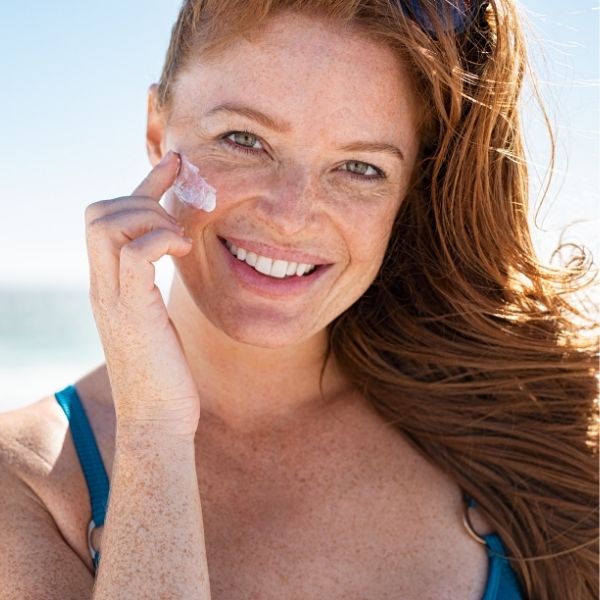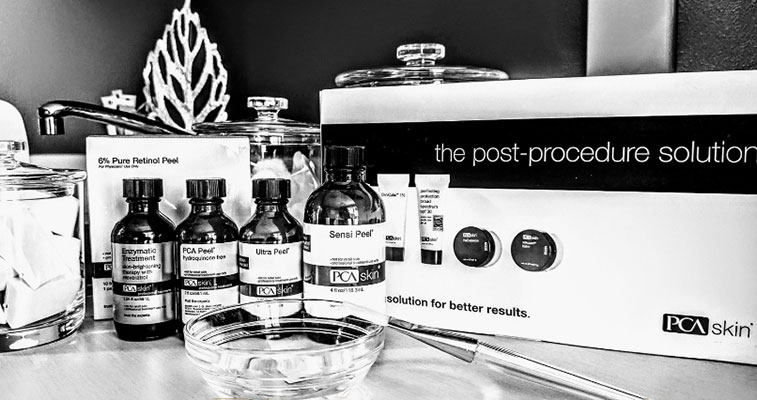As summer quickly approaches, it is a necessity to know the benefits of sunscreen and the difference between physical and chemical SPFs. For those that think all sunscreen is the same, a cursory glance at the skincare section of your local pharmacy or grocery store will reveal that there are dozens upon dozens of options. So, which is the right sunscreen for you?
Protecting your skin from the sun is one of the most important things to add to your beauty regimen this spring and summer. Let’s dig a little deeper to understand the difference between physical and chemical SPFs.

The Benefits of Wearing Sunscreen
Among healthcare professionals, the thought is that any sunscreen is better than no sunscreen at all, and this is for good reason. The skin is the largest organ of the body and must be protected from the sun or risk the possibility of prematurely aging skin or more serious conditions, such as skin cancer.
From a beauty standpoint, the primary benefits of wearing sunscreen are:
From a healthcare perspective, wearing sunscreen also:
One of the biggest myths about wearing sunscreen is that it is only needed when you are outside in the sun. Contrary to popular belief, it is possible to get sunburned even when indoors if sitting near a window, or riding in a vehicle. On average, windows are made to block UVB rays, but not UVA rays. The reason this matters is that UVA rays have the ability to deeply penetrate the skin and are one of the biggest contributors to signs of sun aging, such as wrinkles and dark spots, as well as skin cancer.
Bottom line: Wear sunscreen every day to delay the signs of aging and protect the health of your skin both now and in the future.

The Difference Between Physical and Chemical SPFs
At the most basic level, the main difference between physical and chemical SPFs is that physical (sometimes referred to as mineral) sunscreen reflects the sun’s rays while chemical sunscreen absorbs them.
To break this down a little more, physical or mineral sunscreens are able to better reflect the sun’s rays because they are closer to the surface of the skin. Chemical sunscreens penetrate deep into the skin and are therefore more adept at absorbing UV rays than reflecting them.
Because physical or mineral sunscreens are designed to reflect the sun’s rays by blocking them, this method can make them better for use on sensitive skin as well as conditions such as melasma and hyperpigmentation. It can also be used as post ablative treatments. The active ingredients in mineral sunscreen work together to create an almost immediate physical barrier to protect the skin from the sun and are typically:
Chemical sunscreen is intended to scatter or more commonly absorb the sun’s rays, which can create heat in the skin. This substance is typically sweat and water-resistant and more sheer in nature, so it can be better for oily skin and acne prone skin. Active ingredients of chemical sunscreen are usually:
With these three ingredients of chemical sunscreen, it can take up to twenty minutes or longer to allow full protection from the sun.
How to Choose Between Physical and Chemical SPFs
Both physical and chemical SPFs can be quite effective in keeping the sun’s rays at bay and better protecting the skin, just in two very different ways. When it comes to choosing between the two and determining which is the right one for you, consider the following:
Chemical sunscreen is intended to scatter or more commonly absorb the sun’s rays, which can create heat in the skin. This substance is typically sweat and water-resistant and more sheer in nature, so it can be better for oily skin and acne prone skin. Active ingredients of chemical sunscreen are usually:
With these three ingredients of chemical sunscreen, it can take up to twenty minutes or longer to allow full protection from the sun.
Physical sunscreen can be best for sensitive skin whereas chemical sunscreen can be best for especially acne prone skin that is oily.
How fast you need it to work:Mineral sunscreen tends to create a more immediate barrier, but chemical sunscreen can take twenty minutes or longer to become effective. How fast you need it to work may help determine which one is best for optimum skin protection.
Recommendations by a medical aesthetician:When it comes to something as delicate as the skin on our body, it can be a good idea to enlist the help of a reputable aesthetician. They can do a physical examination of the skin and balance that with the amount of sun exposure you routinely have to make a more customized recommendation. If they work at a reputable facility or spa, they may even have products on hand that they recommend specifically for you.

Taking Care of Your Skin After Sun Exposure
While it is critical to daily prepare and protect your skin against sun exposure, it can be equally important to care for it after exposure. Some of our favorite products for applying to the skin post sun exposure are:
This vitamin C packed antioxidant serum strengthens and hydrates the skin to help reduce the appearance of aging such as wrinkles and fine lines.
PCA Smoothing Toner:The lactic and citric acids along with aloe, make this alcohol-free toner an excellent tool for cleaning and calming the skin, in addition to reducing the appearance of the skin’s pores.
PCA Pigment Bar:A cleansing bar like this helps clean, freshen, and calm the skin to yield a more even skin tone to discolored skin.

The benefits of sunscreen and the difference between physical and chemical SPFs are something every single individual needs to know. We are exposed to the sun’s rays daily, whether it be playing sports outside, riding in a car or bus, or having a window view at the office. Take a proactive approach now in protecting your skin for a more youthful and cancer-free skin in the future. Your skin will thank you for it.
